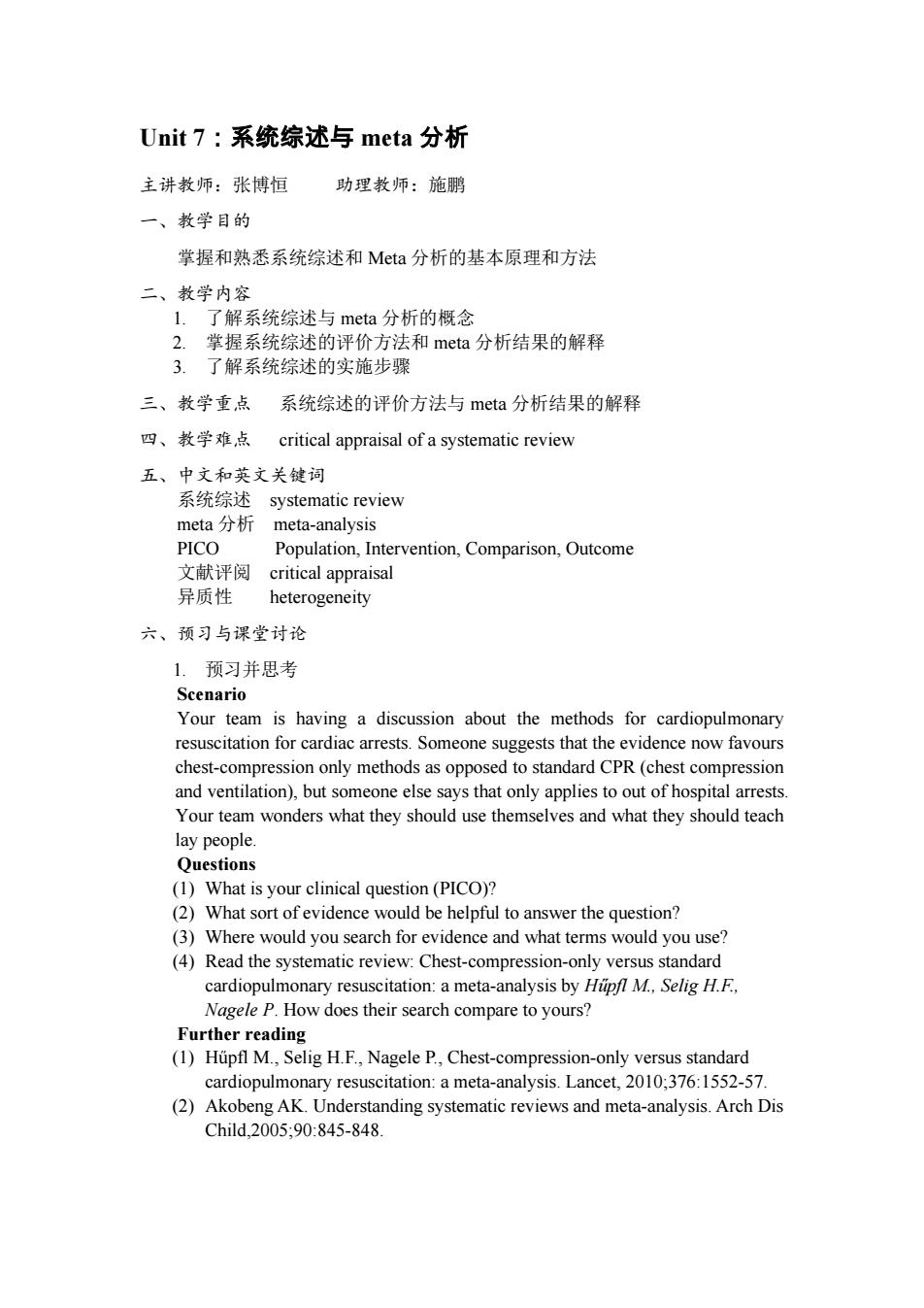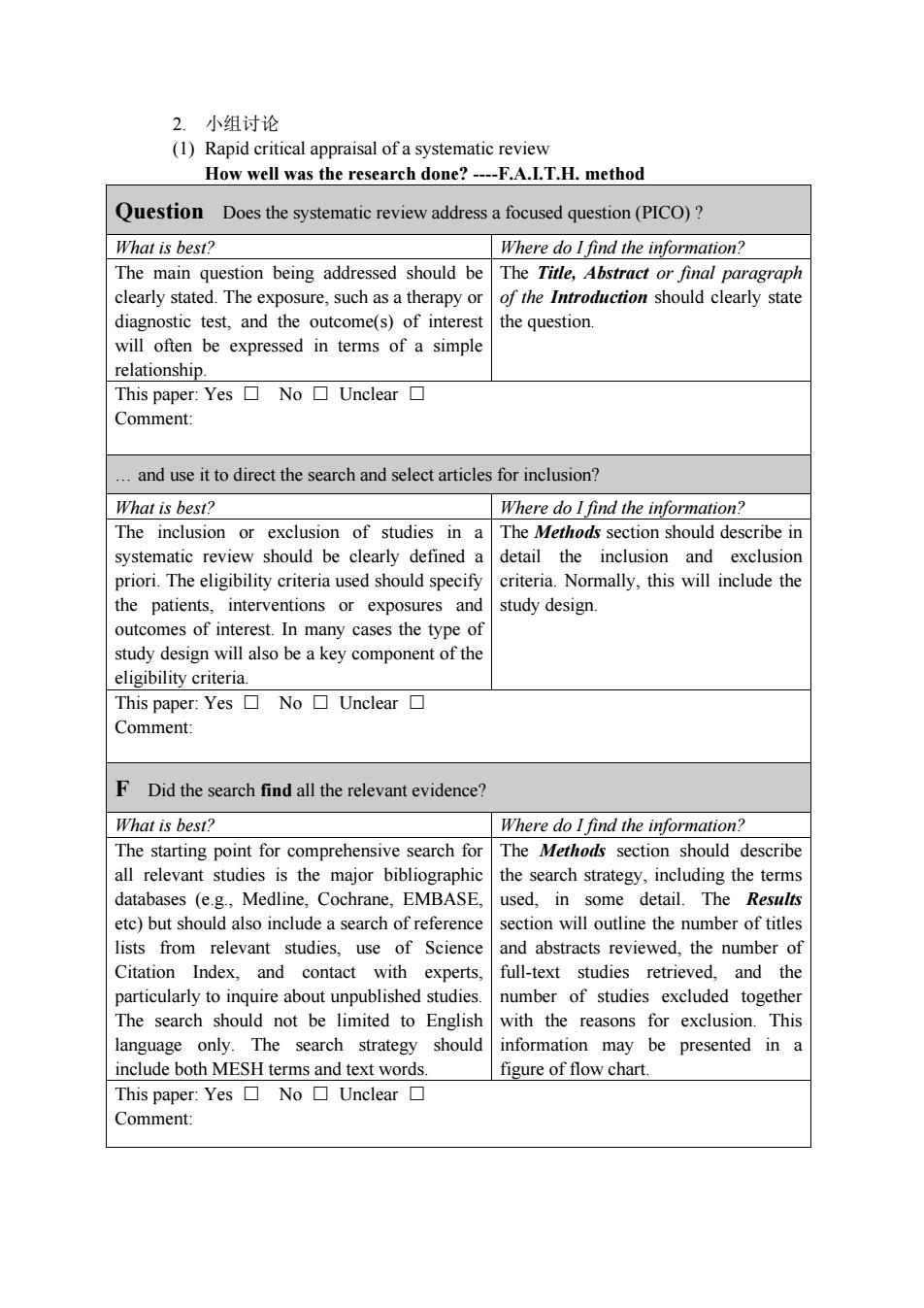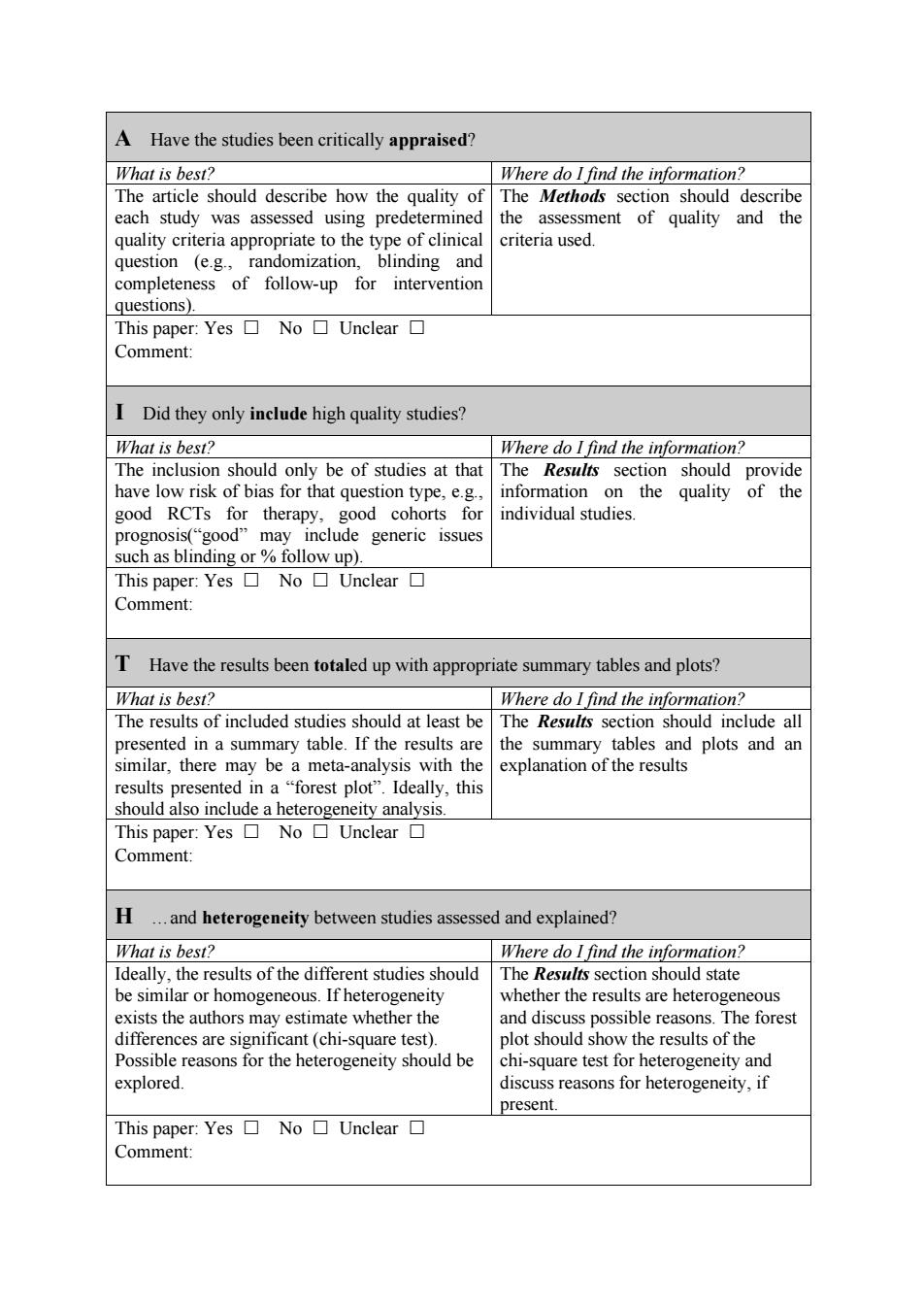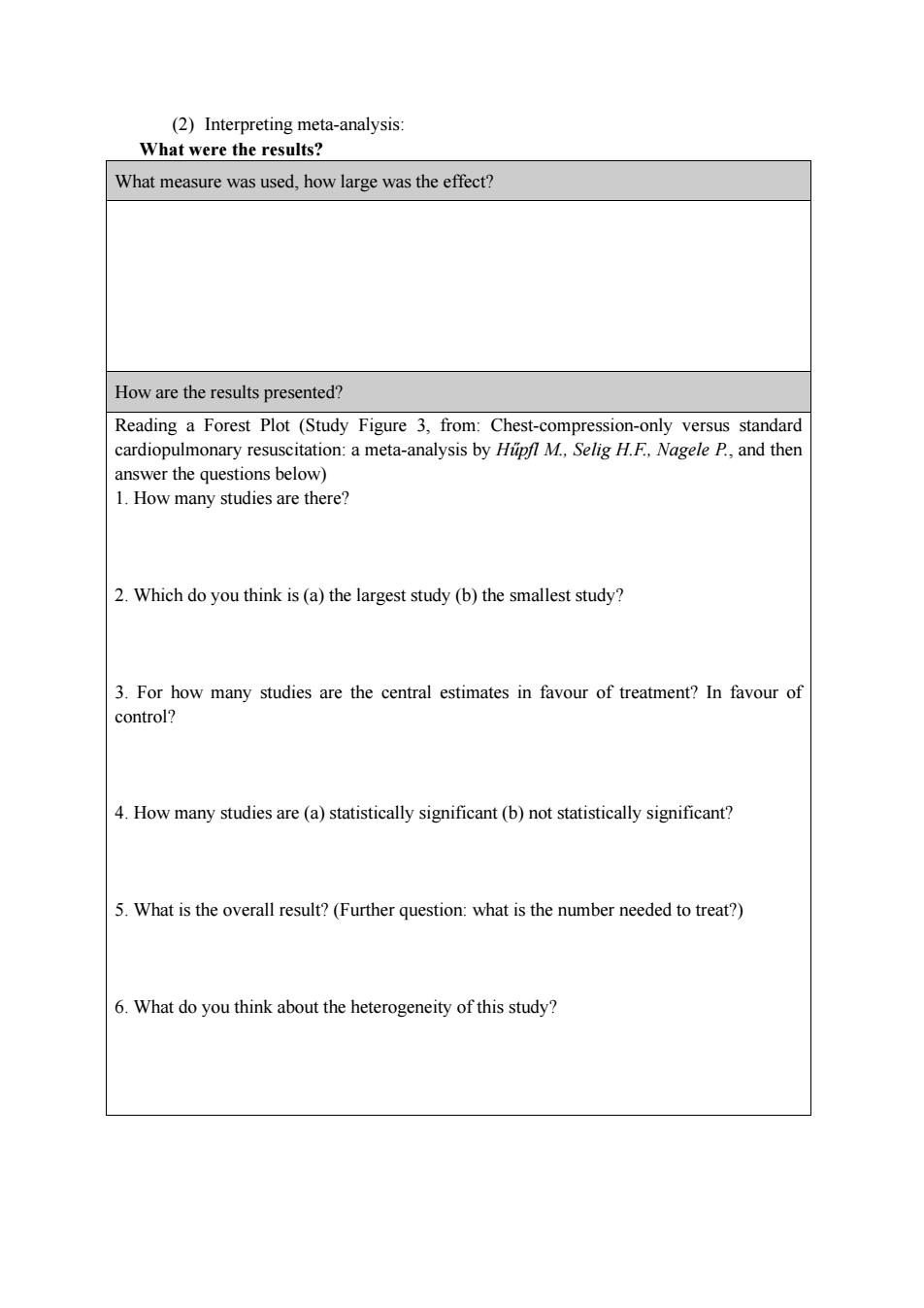
Unit7:系统综述与meta分析 主讲教师:张博恒 助理教师:施鹕 一、教学目的 掌握和熟悉系统综述和Mta分析的基本原理和方法 二、教学内容 1.了解系统综述与meta分析的概念 2.掌握系统综述的评价方法和meta分析结果的解释 3.了解系统综述的实施步骤 三、教学重点系统综述的评价方法与meta分析结果的解释 四、教学难,点critical appraisal of a systematic review 五、中文和英文关健词 系统综述systematic review meta分析meta-analysis PICO Population,Intervention,Comparison,Outcome 文献评阅 critical appraisal 异质性 heterogeneity 六、预习与课堂讨论 1.预习并思考 Scenario Your team is having a discussion about the methods for cardiopulmonary resuscitation for cardiac arrests.Someone suggests that the evidence now favours chest-compression only methods as opposed to standard CPR(chest compressior and ventilation),but someone else says that only applies to out of hospital arrests Your team wonders what they should use themselves and what they should teach lay people. Questions (1)What is your clinical question(PICO)? (2)What sort of evidence would be helpful to answer the question? 3)Where would you search for evidence and what terms would you use? (4)Read the systematic review:Chest-compression-only versus standard cardiopulmonary resuscitation:a meta-analysis by Hipfl M..Selig H.F.. Nagele p.How does their search compare to vours? further reading (1)Hupfl M..Selig H.F,Nagele P.,Chest-compression-only versus standard cardiopulmonary resuscitation:a meta-analysis.Lancet,2010:376:1552-57. (2)Akobeng AK.Understanding systematic reviews and meta-analysis.Arch Dis Child,.2005,90:845-848
Unit 7:系统综述与 meta 分析 主讲教师:张博恒 助理教师:施鹏 一、教学目的 掌握和熟悉系统综述和 Meta 分析的基本原理和方法 二、教学内容 1. 了解系统综述与 meta 分析的概念 2. 掌握系统综述的评价方法和 meta 分析结果的解释 3. 了解系统综述的实施步骤 三、教学重点 系统综述的评价方法与 meta 分析结果的解释 四、教学难点 critical appraisal of a systematic review 五、中文和英文关键词 系统综述 systematic review meta 分析 meta-analysis PICO Population, Intervention, Comparison, Outcome 文献评阅 critical appraisal 异质性 heterogeneity 六、预习与课堂讨论 1. 预习并思考 Scenario Your team is having a discussion about the methods for cardiopulmonary resuscitation for cardiac arrests. Someone suggests that the evidence now favours chest-compression only methods as opposed to standard CPR (chest compression and ventilation), but someone else says that only applies to out of hospital arrests. Your team wonders what they should use themselves and what they should teach lay people. Questions (1) What is your clinical question (PICO)? (2) What sort of evidence would be helpful to answer the question? (3) Where would you search for evidence and what terms would you use? (4) Read the systematic review: Chest-compression-only versus standard cardiopulmonary resuscitation: a meta-analysis by Hűpfl M., Selig H.F., Nagele P. How does their search compare to yours? Further reading (1) Hűpfl M., Selig H.F., Nagele P., Chest-compression-only versus standard cardiopulmonary resuscitation: a meta-analysis. Lancet, 2010;376:1552-57. (2) Akobeng AK. Understanding systematic reviews and meta-analysis. Arch Dis Child,2005;90:845-848

2.小组讨论 (1)Rapid critical appraisal ofa systematic review How well was the research done?-F.A.I.T.H.method Question Does the systematic review address a focused question(PICO)? What is best? Where do I find the information? The main question being addressed should be The Title, paragraph clearly stated.The expsresuchasa therapy of the Introduction should clearly state diagnostic test,and the outcome(s)of interest the question. will often be expressed in terms of a simple relationship This paper:Yes No Unclear Comment .and use it to direct the search and select articles for inclusion? What is best? Where do Ifind the information? The inclusion or exclusion of studies in a The Methods section should describe in systematic review should be clearly defined a detail the inclusion and exclusion oriori The eligibility criteria used should specify criteria Normally.this will include the he patients. ter entions or expo ures and study design. mes of in terest.In many cases the type of study design will also be a key component of the eligibility criteria. This paper:.Yes▣No▣Unclear▣ Comment FDid the search find all the relevant evidence? What is best? Where do I find the information? The starting point for comprehensive search for section should describ all relevant studies is the major bibliographic the search strategy,including the terms databases (e.g.,Medline,Cochrane,EMBASE used,in some detail.The Resulrs etc)but should also include a search of reference section will outline the number of titles lists from relevant studies,use of Science and abstracts reviewed,the number of Citation Index, and contact with experts full-text studies retrievec and the particularly to inquire about unpublished studies number of studies excluded together The search should not be limited to English with the reasons for exclusion.This language only.The search strategy should information may be presented in a include both MESH terms and text words figure of flow chart. This paper:Yes▣ No▣Unclear Comment:
2. 小组讨论 (1) Rapid critical appraisal of a systematic review How well was the research done? ----F.A.I.T.H. method Question Does the systematic review address a focused question (PICO) ? What is best? Where do I find the information? The main question being addressed should be clearly stated. The exposure, such as a therapy or diagnostic test, and the outcome(s) of interest will often be expressed in terms of a simple relationship. The Title, Abstract or final paragraph of the Introduction should clearly state the question. This paper: Yes □ No □ Unclear □ Comment: … and use it to direct the search and select articles for inclusion? What is best? Where do I find the information? The inclusion or exclusion of studies in a systematic review should be clearly defined a priori. The eligibility criteria used should specify the patients, interventions or exposures and outcomes of interest. In many cases the type of study design will also be a key component of the eligibility criteria. The Methods section should describe in detail the inclusion and exclusion criteria. Normally, this will include the study design. This paper: Yes □ No □ Unclear □ Comment: F Did the search find all the relevant evidence? What is best? Where do I find the information? The starting point for comprehensive search for all relevant studies is the major bibliographic databases (e.g., Medline, Cochrane, EMBASE, etc) but should also include a search of reference lists from relevant studies, use of Science Citation Index, and contact with experts, particularly to inquire about unpublished studies. The search should not be limited to English language only. The search strategy should include both MESH terms and text words. The Methods section should describe the search strategy, including the terms used, in some detail. The Results section will outline the number of titles and abstracts reviewed, the number of full-text studies retrieved, and the number of studies excluded together with the reasons for exclusion. This information may be presented in a figure of flow chart. This paper: Yes □ No □ Unclear □ Comment:

A Have the studies been critically appraised? What is best? Where do I find the information? eshould describe how the quality he Methods section should des stu was assess ng prede assessment of quality and a appro pria the type clini criteria used inding and complete ness of follow-up for intervention This paper:Yes No Unclear Comment: I Did they only include high quality studies? What is best? Where do I find the informa on? The nclusion should only be of studies at that The results should have low risk of bias for that question type information on the quality of the good RCTs for therapy good cohorts for individual studies such as blinding or follow up). This paper:.Yes▣No▣Unclear▣ Comme T Have the results been totaled up with appropriate summary tables and plots? What is best? Where do I find the information? The results of included studies should at least be The Results section should include all presented in a summary table.If the results are the summary tables and plots and an similar,there may be a meta-analysis with the explanation of the results results presented in a "forest plot".Ideally,this should also include a heterogeneity analysis. This paper:Yes▣No▣Unclear▣ Comment: H ..and heterogeneity between studies assessed and explained? What is best? Where do Ifind the information? Ideally,the results of the different studies should The Results section should state be similar or homogeneous.If heterogeneity ther the results are heterogeneous exists the authors may estim te whether the sibi0Cesares nt(chi-qrte) le reasons.The forest reasons for the heterogeneity should be quare test I explored present This paper:Yes▣No▣Unclear▣ Comment:
A Have the studies been critically appraised? What is best? Where do I find the information? The article should describe how the quality of each study was assessed using predetermined quality criteria appropriate to the type of clinical question (e.g., randomization, blinding and completeness of follow-up for intervention questions). The Methods section should describe the assessment of quality and the criteria used. This paper: Yes □ No □ Unclear □ Comment: I Did they only include high quality studies? What is best? Where do I find the information? The inclusion should only be of studies at that have low risk of bias for that question type, e.g., good RCTs for therapy, good cohorts for prognosis(“good” may include generic issues such as blinding or % follow up). The Results section should provide information on the quality of the individual studies. This paper: Yes □ No □ Unclear □ Comment: T Have the results been totaled up with appropriate summary tables and plots? What is best? Where do I find the information? The results of included studies should at least be presented in a summary table. If the results are similar, there may be a meta-analysis with the results presented in a “forest plot”. Ideally, this should also include a heterogeneity analysis. The Results section should include all the summary tables and plots and an explanation of the results This paper: Yes □ No □ Unclear □ Comment: H …and heterogeneity between studies assessed and explained? What is best? Where do I find the information? Ideally, the results of the different studies should be similar or homogeneous. If heterogeneity exists the authors may estimate whether the differences are significant (chi-square test). Possible reasons for the heterogeneity should be explored. The Results section should state whether the results are heterogeneous and discuss possible reasons. The forest plot should show the results of the chi-square test for heterogeneity and discuss reasons for heterogeneity, if present. This paper: Yes □ No □ Unclear □ Comment:

(2)Interpreting meta-analysis: What were the results? What measure was used,how large was the effect? How are the results presented? Reading a Forest Plot (Study Figure 3.from:Chest-compression-only versus standard tation:a meta-analysis by Hipn M.Selig H.E.Nagele o P and ther answer the questions below) 1.How many studies are there? 2.Which do you think is(a)the largest study(b)the smallest study? 3.For how many studies are the central estimates in favour of treatment?In favour of control? 4.How many studies are(a)statistically significant(b)not statistically significant? 5.What is the overall result?(Further question:what is the number needed to treat?) 6.What do you think about the heterogeneity of this study?
(2) Interpreting meta-analysis: What were the results? What measure was used, how large was the effect? How are the results presented? Reading a Forest Plot (Study Figure 3, from: Chest-compression-only versus standard cardiopulmonary resuscitation: a meta-analysis by Hűpfl M., Selig H.F., Nagele P., and then answer the questions below) 1. How many studies are there? 2. Which do you think is (a) the largest study (b) the smallest study? 3. For how many studies are the central estimates in favour of treatment? In favour of control? 4. How many studies are (a) statistically significant (b) not statistically significant? 5. What is the overall result? (Further question: what is the number needed to treat?) 6. What do you think about the heterogeneity of this study?

七、参考书及文献 .《循证医学与临床实践》(第3版).王吉耀主编,科学出版社,2012. 2. The Cochrane Handbook for Systematic Reviews af nterventions (formerly the Reviewers'Handbook)is available on the Cochrane Collaboration website(http://www.cochrane org/recources/handbook/) 3.Elaine M.Beller,Paul P.Glasziou,Douglas G.Altman,ete.PRISMA for Abstracts:Reporting Systematic Reviews in Journal and Conference Abstracts.PLOS Medicine,0() 4.David Moher,Alessandro Liberati,Jennifer Tetzlaff,Douglas G.Altman,The PRISMA Group.Preferred Reporting Items for Systematic Reviews and Meta-Analyses:The PRISMA Statement.PLOS Medicine,2009:6(7)
七、参考书及文献 1. 《循证医学与临床实践》(第 3 版).王吉耀主编,科学出版社,2012. 2. The Cochrane Handbook for Systematic Reviews of Interventions (formerly the Reviewers’Handbook) is available on the Cochrane Collaboration website (http://www.cochrane.org/recources/handbook/) 3. Elaine M. Beller, Paul P. Glasziou, Douglas G. Altman, etc. PRISMA for Abstracts: Reporting Systematic Reviews in Journal and Conference Abstracts. PLOS Medicine, 2013;10(4). 4. David Moher, Alessandro Liberati, Jennifer Tetzlaff, Douglas G. Altman, The PRISMA Group. Preferred Reporting Items for Systematic Reviews and Meta-Analyses: The PRISMA Statement. PLOS Medicine,2009;6(7)